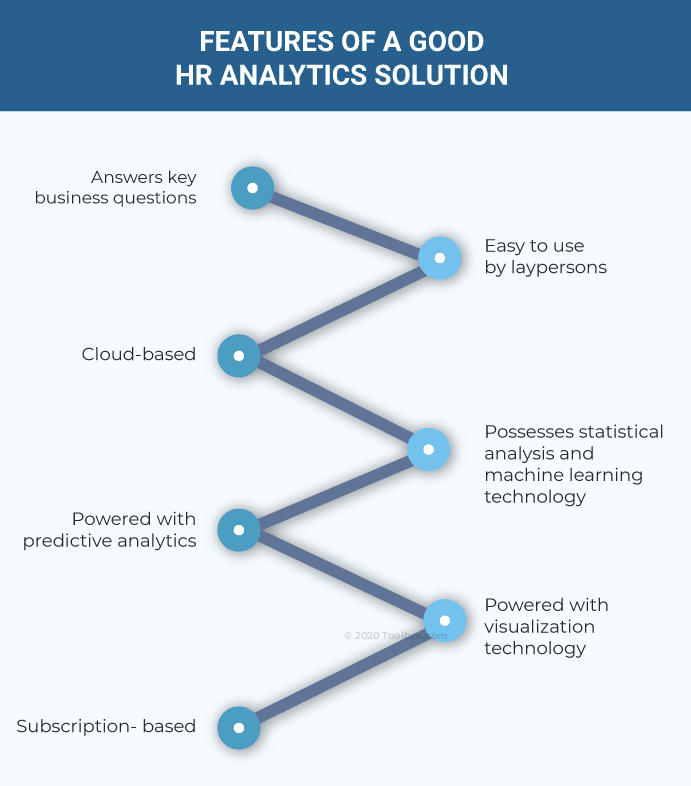
Simply put, HR analytics refers to creating insights on how investments in human capital assets contribute to the success of four principal outcomes - revenue generation, risk mitigation, strategic planning execution, and expense reduction.
In recent years, HR has undergone tremendous changes. Traditionally, the department was more human-centric, making it difficult to quantify and measure success as in the sales department. But that is not the case anymore.
With increased responsibility as a business partner, HR is being called to quantify their actions to demonstrate organizational impact. HR analytics taps into data routinely collected by HR and correlates it to HR and corporate objectives.
You see, it takes time and investment to bring employees up to a fully productive level. HR analytics merely provides data-backed insight into what is working well and what is not so that companies can make improvements and plan more effectively for the future.
Types of HR analytics
HR analytics is often interchangeably used with people analytics, workforce analytics, and talent analytics. However, there are broadly three types of HR analytics, including predictive, descriptive, and prescriptive - each offering a different perspective on company data:
1. Descriptive analytics
Descriptive analytics involves interpreting historical (often raw) data to better understand the changes in a business. For instance, a headcount summary of all employees in an organization is a form of descriptive analytics.
2. Predictive analytics
As the name suggests, predictive analytics works to look ahead. Statistical models and forecasts are used to answer the question of what can happen. For instance, it can help determine whether someone will be a good cultural fit or how long an employee will stay.
3. Prescriptive analytics
Prescriptive analytics offers recommendations on what to do based on information retrieved from descriptive and predictive analytics. For instance, it helps determine how to onboard a new hire adequately based on their skills and strengths.
Top HR analytics metrics
HR analytics is genuinely a data-driven method that helps improve decisions impacting HR functions. It is highly influenced by the quality of data collected from key metrics, such as time to hire, human capital risk, average absenteeism risk, training expense per employee, and so on.
If you revamp your recruitment process to eliminate poor predictors and start focusing on concrete candidate ability, you should start seeing positive results. To know precisely how well your changes are working, here are some essential metrics to track:
1. Employee turnover
This measures how many employees are leaving your company within a fixed period, usually a year. It is calculated by dividing the number of terminations/resignations during the year by the number of people hired during the year and then multiplying that figure by 100.
The average turnover across industries is estimated at around 17%. The lower your turnover is than this average, the better you are doing as a company.
2. Revenue per employee
This is calculated by dividing a company’s revenue by the total number of employees in the company. In a nutshell, the metric is an indicator of the average revenue every employee generates within a time frame.
3. First-year attrition rate
This measures the number of employees who leave within the first year of getting hired. While some of these could include terminations from the company’s end (known as ‘managed’ attrition), others are employees who choose to quit, which happens most often because they have not received the resources and support they need to fit into the job.
4. Time to productivity
This is a measure of the learning curve or the number of days it takes for a new hire to become entirely comfortable with and on the job. Quite naturally, a shorter time to productivity indicates your onboarding process is sound and that the candidate was a good fit, to begin with.
5. Offer acceptance rate
This calculates the number of accepted formal job offers divided by the total number of job offers given in a certain period. Obviously, a higher rate (above 85%) indicates a good ratio. If it is lower, there is a need to revamp the company’s talent acquisition strategy.
6. Employee engagement
This measures the employee's connection with their job and with the company. Higher engagement, naturally, translates to more daily motivation and more productivity.
You can track employee engagement by sending out surveys where new hires rate how satisfied they feel with their jobs and teams and their recruitment and onboarding experience.
You could also note work efficiency metrics - if your employees are consistently performing below par, it could indicate that they are not sufficiently engaged at work.
Benefits of HR analytics
There is no doubt that analytics helps a business become more strategic and systematic. Data helps tackle current issues and plan better for future activities. Adding to that thought, here are the top X benefits that HR analytics brings to the table:
1. Improved talent acquisition
Acquiring talent is an important activity for any organization that must be undertaken all year round. The candidate selection process is a huge task, and when you do find someone fitting for the job, you can only hope everything goes well and join the company.
How many candidates are interviewed before actually filling the job vacancy? Which candidate sourcing channels work the best for you? How many candidates did you reach out to close a position? These are some of the questions that you could look at resolving through analytics.
Track recruitment metrics such as cost per hire, quality of hire, application completion, and so on to make adjustments to your talent acquisition process.
2. Reduced staff attrition
Employee retention is becoming harder by the day, especially with the younger workforce switching jobs frequently. Therefore, make it a habit to conduct exit interviews. Understand why employees want to leave or what could make them stay.

Find patterns in the gathered information to understand what is causing attrition and put remedial measures in place to avoid that in the future.
3. Improved employee experience
Many organizations fail to realize that employee experience starts at hiring. Your first interaction with a candidate before hiring is equally important compared to your experience with them on their first day of work.
When you are aware of the factors that affect employee experience positively and negatively, you can deliver an optimal experience to them. HR analytics arms you with the numbers you need to make decisions worth it.
4. Productive workforce
Employee productivity levels are never constant and are bound to be negatively impacted by many factors, including toxic workplace behavior, multitasking, lack of recognition, and so on.
Gathering data on what is hampering employees' productivity will help you take corrective measures that keep the workforce happy and on track and benefit your company’s bottom line.
5. Better training
Professional development is an integral part of company culture. Helping your employees grow and learn new skills will directly impact their performance. Collecting data about where employees will need upskilling allows you to identify if they are making the most of training opportunities and whether the training is relevant to them.
Disadvantages of HR analytics
- Access to quality data can be a problem for companies that do not have up-to-date systems.
- Smaller HR teams may not always have the statistical and analytical skill set for working with large datasets.
- Different management and reporting systems in the company can make it difficult to aggregate and compare data.
- It is possible to miss opportunities or derive untrue insights if the HR team uses a complex tool and is not skilled in data analysis.
- If HR analytics tools having access to sensitive information do not fulfill the right security standards, it could lead to potential security issues.
- The company must adhere to its country’s data privacy laws. Those who fail to secure employee personal data or are found to be misusing personal data face hefty penalties.
How to implement HR analytics in your organization
Do you want to deploy HR analytics in your organization? In the following section, we will tell you how to establish and implement HR data collection and analysis step-by-step:
1. Create a plan of action
Identify the HR-related issues you want to focus on. This could include shortening the time to fill a job vacancy or optimizing your onboarding process. The entire HR department should sit down and critique how they are functioning.
Ask yourself:
- “What do we need to measure?”
- “What timeframes are we looking at?”
- “What events or values are necessary to forecast?”
Look at all data types that will best serve your organizational needs and help you create an informed-decision model using data analytics. Then, introduce custom KPIs in addition to your standard HR metrics - keeping track of which will help you make significant adjustments.
Some examples of metrics include early turnover, performance and potential, engagement rating, billable hours per employee, cost of HR per employee, and so on.
2. Define data sources
Once you have identified metrics to track, documenting sources from where to pull the data will not be difficult. You could utilize applicant tracking systems, skill assessment tests, training systems, ERP HR modules, and so on to gather data.
If you also plan to consider data that candidates or current employees share on social media sites or Slack/Discord/Skype channels, add these portals to your list. Please ensure you have access to individual-level data collected by external survey companies.
3. Decide on a tool
After you have decided on the sources to leverage for data collection, outline the tasks your HR team will be required to perform along with the metrics and KPIs to measure and forecast. You could go for off-the-shelf solutions such as Gusto, Namely, and Zoho People.

Choose a solution that fulfills all your objectives and can be easily used by everyone on the team. Having an overly complicated system will only make things difficult for you.
4. Gather a team
Just because it is called “HR analytics,” it does not mean employees from other functions cannot be a part of the process. Here are some of the experts you must have in your HR analytics team besides the HR personnel:
- A database administrator responsible for database management
- An HR manager responsible for building and maintaining HR plans and operations
- A data analyst to define ways to retrieve data from sources to solve a specific problem
- A data scientist for handling data analysis and uncovering insights about the organization’s operations
Of course, team structure depends on solution complexity, timelines, and budget. One specialist can have more responsibilities. For instance, a data scientist can be in charge of data collection, data selection, and visualization.
5. Train employees on how to use the system
Analytics, in general, challenges the status quo at work, so HR must equip itself with the knowledge to make the most of the new technology. Training is, therefore, a must as it shows the new system functionality. Video tutorials and interactive virtual onboarding tools effectively instruct the end-users.
6. Get creative and collaborate
Figure out ways to avoid functional silos by defining clear KPIs for the team. Real-time data processing and advanced data mining techniques simplify data accessibility and analysis. Derive maximum business benefits by streamlining the HR analytics process and applying quality controls. Get the team to contribute to it equally.
7. Ensure legal compliance
Avoid hefty fines and penalties by complying with the ever-changing data protection laws and privacy regulations. Legally vet all data sourcing techniques and publishing processes. Explain the legalities to managers, executives, and HR personnel so that you do not overstep and breach any employees’ right to privacy. Consult a specialist in employment law for assistance.
Over to you
Utilizing HR analytics does not mean you purchase expensive software, set up a huge specialized team, and overwhelm yourself with enormous volumes of data. Start small.
Have conversations with employees, record their responses, add managers from various functions, make a plan, and commit to it. Use the data retrieved to drive initiatives, remedy any existing problems, and introduce positive organizational changes. Good luck!

Asavari is an EiR at Adaface. She has made it her mission to help recruiters deploy candidate-friendly skill tests instead of trick-question based tests. When taking a break, she obsesses over art.
Spending too much time screening candidates?
We make it easy for you to find the best candidates in your pipeline-
with a 40 min skills test.


